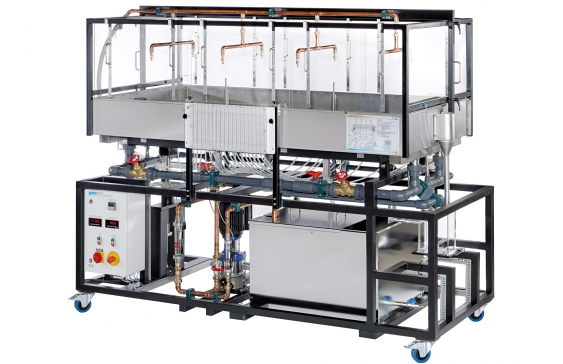HM 145 Advanced hydrological investigations

HM 145 can be used to study seepage and groundwater flows after precipitation. Furthermore, sediment transport in courses of rivers is also presented in the context of flow obstacles. Variable precipitation density and areas and different groundwater supply and drain possibilities allow a wide variety of experiments.
HM 145 contains a closed water circuit with storage tank and pump. The core element is a sand-filled, stainless steel experiment tank with inclination adjustment. To study precipitation, a precipitation device is available, which is equipped with a timer to define the times of precipitation. The precipitation device consists of two groups of four nozzles. Water can flow in (groundwater) or out (drainage) via two chambers on the side. The experiment tank is separated from the chambers by fine mesh screens. To study the lowering of groundwater, two wells with open seam tubes are available. By means of a small weir in the supply and drain, a course of a river can be generated. Different water levels can be generated. Water supply and water drain can be opened and closed, thus allowing a wide variety of experimental conditions. In addition, three different models make it possible to study the flow around obstacles and the resulting sediment transport in the river bed.
At the bottom of the experiment tank there are measuring connections to detect groundwater levels, which are displayed on 19 tube manometers. Two flow meters with different measuring ranges indicate the supply to the experiment tank. A measuring tank at the drain contains a measuring weir for determining the water level and a force sensor for determining the amount of sediment.
The measured values are indicated at the trainer. At the same time, the measured values can also be transmitted directly to a PC via USB. The data acquisition software is included.
- seepage flows and groundwater flows in soils
- supply and drain (groundwater and running waters) over a large area and at individual points
- sediment transport and obstacles in running waters
Experiment tank, inclination adjustment: -1…5%
- area: 2x1m2, depth: 0,2m, max. sand filling: 0,3m3
Precipitation device
- 8 nozzles, switchable in 4 groups of 2 nozzles
- flow rate: 1…4,7L/min, square spray pattern
Pump
- power consumption: 0,55kW
- max. flow rate: 1500L/h
Storage tank, stainless steel: content 220L
Measuring ranges
- 19 tube manometers: 300mmWC
- flow rate (supply): 0…1050L/h, 0…320L/h
- flow rate (drain): 0…1000L/h
- mass/sediment: 0…5000g
230V, 50Hz, 1 phase
230V, 60Hz, 1 phase; 120V, 60Hz, 1 phase
- investigation of precipitation-discharge relationships, storage capacity of soils, seepage flows, groundwater flows and sediment transport
- closed water circuit
- inclinable stainless steel experiment tank contains 19 measuring connections to detect groundwater levels, transparent splash guard and screens for separating the chambers
- 2 wells with open seam tubes in the experiment tank
- precipitation device with 8 nozzles, adjustable
- precipitation time can be adjusted via timer
- water supplies and drains can be selected individually
- transparent measuring tank (flow) and force sensor (determining the amount of sediment)
- 3 models for pillars: round, square, oval
- instruments: tube manometers (groundwater), flow meter (2x at the supply) and measuring weir in the measuring tank (1x at the drain)
- GUNT software for data acquisition via USB under Windows 7, 8.1, 10
- investigating transient processes
- effect of rainfall of varying duration on the discharge
- storage capacity of a soil
- investigating steady processes
- seepage flow
- effects of wells on the groundwater level over time
- flow behaviour of rivers, obstacles in the river bed, sediment transport in rivers



